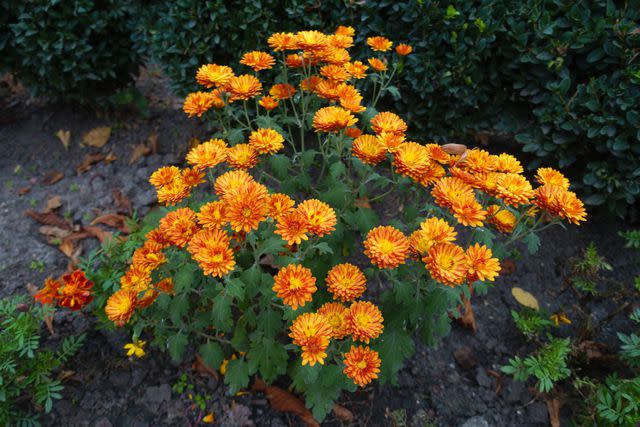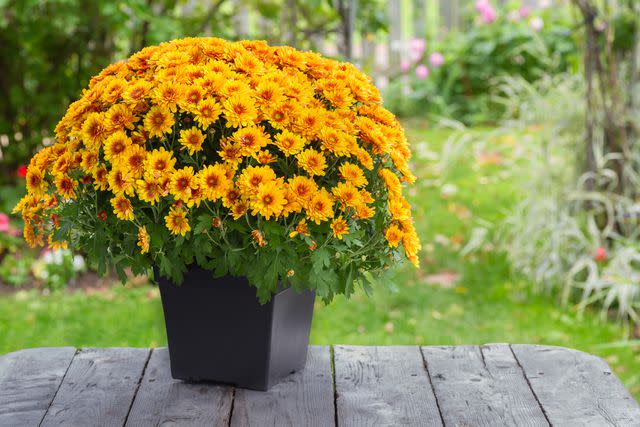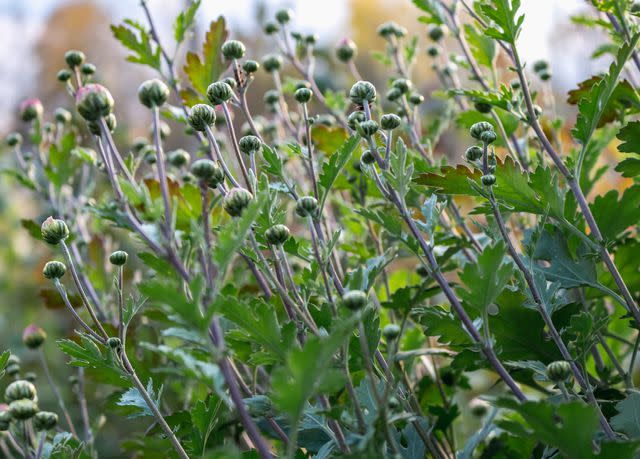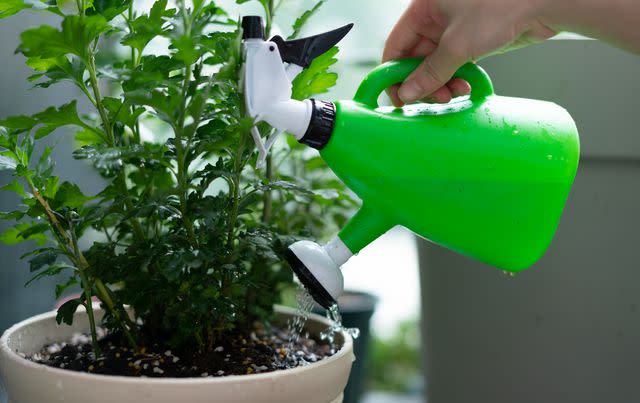Mums Are Actually Perennial Plants—Here's How to Take Care of Them
There's a difference between florist and garden mums
There are two different types of mums, florist mums and garden mums. Botanically, they are both members of genus Chrysanthemum, and there are many hybrids in each category. The main difference between florist mums and garden mums is their life cycle. Florist mums are grown as annuals that don’t come back every year, whereas garden mums, also known as hardy mums, are perennials.
A sure way to tell the two types of mums apart is that florist mums as usually sold in pots in the fall, covered with numerous flower buds that are just about to open. Garden mums, on the other hand, can be found at nurseries already in the spring; they have a loser growth habit, and more of the foliage is visible between the flowers.
Read on to learn about growing mums as perennials vs. annuals.

What Kind of Mums Should You Plant?
Florist Mums
This is the type of ubiquitous fall mums that is typically sold at floral shops, supermarkets, and greenhouses. These are grown specifically to sell in pots for the fall flowering season.
These bushy plants grow 1 to 2 feet tall at maturity and can spread just as wide. The plants are so densely covered with small blooms that the foliage is barely visible and secondary. The leaves of florist mums are slightly more delicate than the leaves of garden mums, they tend to be thinner and narrower and often less toothed than the leaves of garden mums.

onepony / Getty Images
Florist mums come in a wide range of colors, including white, yellow, pink, orange, red, burgundy, cream, salmon, and bi-colored. When you buy florist mums, select ones that have as many closed buds as possible because the number of buds determines the length of flowering. Once there are no more buds, the plant is at the of its life cycle and it is discarded.
Although florist mums are potentially winter-hardy in zone 7 to 9, this type of mum is not meant to survive the winter. The plants have very shallow roots, which makes them ill-equipped for the winter even in a warm climate.
Because of their short lifespan, florist mums are usually planted in pots and not in the ground, which makes it easier to dispose of them after they have served their purpose as a fall flower display.
Garden Mums
Just like florist mums, hardy mums flower in the fall, but they are planted in the spring so that they have the full growing season to get established. Hardy mums grow underground shoots, or stolons, which give them the ability to survive the winter and come back every year. They are hardy in zones 4 to 9.
The plants grow fast, reaching their mature height of 1 to 3 feet in height and 1 to 2 feet in width in a single growing season. Their growth habit is less dense and looser than that of florist mums with fewer but larger flowers. In garden mums, more of the foliage is visible. In terms of colors, hardy mums offer just as many choices as florist mums.

Alla Vanahs / Getty Images
Garden mums start to set buds when the days get shorter in the late summer. They bloom in late summer to fall and for a period of up to eight weeks.
Garden mums are best planted in the landscape and not in pots because their roots need room to grow and in garden soil, they are also better insulated against both summer heat and winter cold.
How to Care for Mums the Right Way
Despite the differences between florist mums and garden mums, caring for these fall-flowering plants is not that different.
All mums need plenty of sunlight, at least six hours of sunlight. In too much shade, they will turn leggy and bloom less prolifically.
The soil should be rich, moist, and well-drained. If the soil at the intended location is not ideal, before planting, amend it with organic matter to improve the soil quality and drainage. The soil pH should be slightly acidic to neutral (6.2 to 7.0). Because most florist mums are rootbound, it is recommended that you replant it in a slightly larger pot with fresh potting mix as soon as you buy the plant.
Like all potted plants, florist mums need frequent watering, usually daily in hot weather. Garden mums, once established, have moderate watering needs but do better with consistent moisture.
Garden mums should be fertilized well in the spring with a slow-release granular fertilizer and again in mid-summer with a fertilizer that is high in phosphorus to promote blooming. Avoid any late-summer fertilization as it leads to excessive vegetative growth that is vulnerable to cold damage.
Give potted florist mums a quick nutrient boost by adding a complete liquid fertilizer, diluted to half strength, about once a week.
To encourage garden mums to grow bushier once the plants have grown about 6 inches tall in the spring, you can pinch the tips of each branch a couple of times through mid-summer. Florist mums benefit from deadheading.

Xiuxia Huang / Getty Images
Frequently Asked Questions
How do I know if my mums are annual or perennial?
Any potted mum that you find for sale at a floral shop, supermarket, or other retailer in the late summer or fall and that is either full of flower buds or flowering is most likely an annual florist mum. Mums sold by nurseries in the spring are usually perennials.
How do I save my potted mums for next year?
No matter how well you take care if it, if your potted mum is a florist mum, it is highly unlikely that you will be able to save it for next year. Mums that are able to survive the winter need to be planted in the spring, not in the fall, and potted mums simply lack the root system to survive the winter.
Can you plant mums in the ground?
Florist mums can be planted in the ground if you don’t mind the effort of digging it out again in the late fall when it is done blooming. Note that planting a florist mum in the ground is purely a question of landscape design; it does not increase its chance of surviving winter. Garden mums, on the other hand, should be planted in the ground. Dig a hole slightly larger than the pot and just as deep as the root ball.
Read Next: How Long Do Mums Last and When Do They Bloom?
Read the original article on The Spruce.

